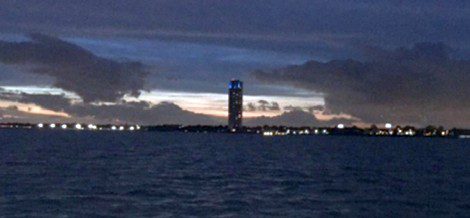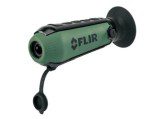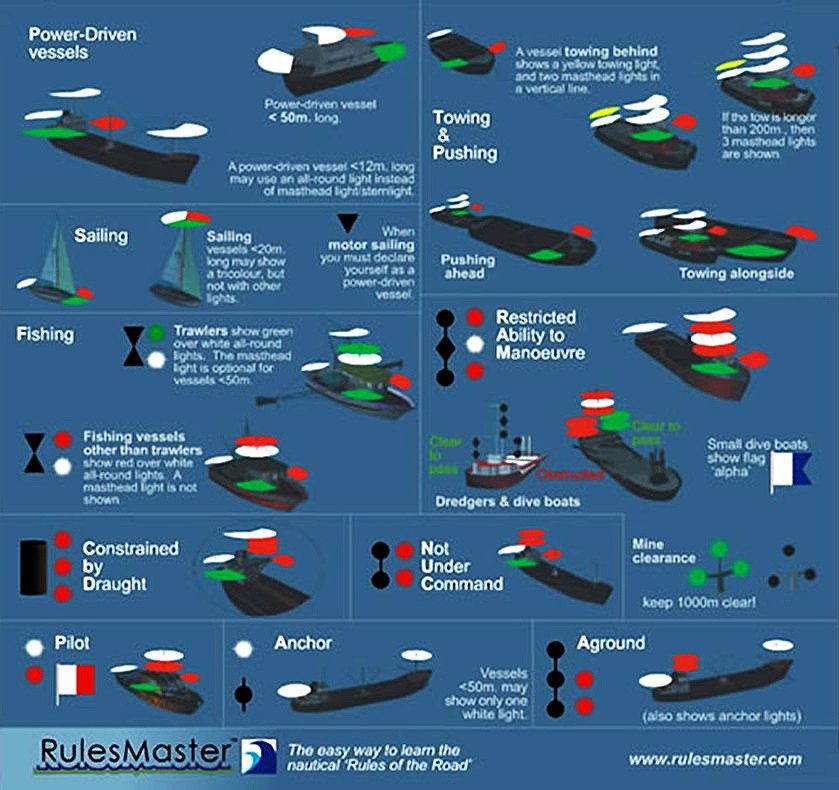 By Bob Currie, Recreational Boating Safety Specialist
By Bob Currie, Recreational Boating Safety Specialist
U. S. Coast Guard Auxiliary Station Galveston Flotilla
Since two thirds of the earth’s surface is covered by water, it is only natural that humans find means to get around on the water. We have progressed from holding onto a floating log to operating some of the most sophisticated means of travel. Can you imagine what Columbus’s voyages would have been like if his ships were equipped with sonar, GPS navigation, radar, and infrared imaging? He might have actually made it to India. All these devices are not only available to the average boater, but they are also becoming more affordable. That said, operating on the water at night requires adherence to both regulations different from day running regulations and to rules of the road designed to prevent a collision at sea. Here are the main considerations.
Recent Nighttime Boating Fatalities
This past weekend (August 5-7, 2022) two boats collided in the ICW/Bastrop Bayou intersection in Texas. Two people were killed in that accident. The same weekend a boat with three persons on board collided with a barge on the Tennessee River, killing three persons. Finally, a boat hit a concrete power pole foundation in Panama City, killing the sole occupant. In 2021, the last full year for which we have recreational boating accident statistics, there were 876 accidents that occurred at night, and these accidents resulted in 138 deaths and 506 injuries. These were just the fatalities. A barge tow ran over two recreational boats, one towing the other, in the ICW just off Bolivar Peninsula.

Boating at Night Main Considerations
The main considerations for boating at night are really just extensions of boating in the daytime. First, you want to be able to see where you are going. Second, you want to be seen by other boaters. Third, you don’t want to run into stuff (above or below the water). The third consideration is basically a function of the first two considerations, except that the third consideration also includes avoiding items that are below the waterline. We won’t discuss the weather issue, as that is a column in itself. We will assume that you have done your pre-launch job and determined that the weather and seas are favorable for your nighttime operation. There are three other boats operating on the water besides our boat in the picture above. Can you see them? We could, but only on our radar.
Post a Lookout
Like all living organisms, humans have senses that allow them to move safely within their environment. The two primary senses that sailors use on the water, no matter the time of day or night, are our eyes and ears. The only position on a boat that is required by law is the lookout. Rule 5 of the Rules of the Road says that you must designate someone to watch for dangers that may come from any direction. “Every vessel shall at all times maintain a proper look-out by sight and hearing as well as by all available means appropriate in the prevailing circumstances and conditions so as to make a full appraisal of the situation and of the risk of collision.” Although you may have the latest electronic innovations such as GPS, radar, and infrared, your primary means of avoiding a collision remain your eyes and ears. That said, the rules also state that you must use all means available to avoid a collision, and that includes those electronic devices mentioned above.
Obstructions
We are still talking about our first consideration, which is seeing where you are going. One of the most important things you can do to enhance your ability to see obstructions is to slow down. You do not want to overrun the limits of your vision; that is, you want to be able to stop short of or steer clear of objects you sight in the water. Obstructions above the water include other vessels, land (yes, people run upon land all the time at night), jetties (a vessel with three persons aboard was recently rescued whenever they ran onto the Galveston north jetty), fixed objects such as gas wells (lighted and unlighted) aids to navigation (lighted and unlighted), crab pot floats, and debris in the water. Obstructions below the water include crab pots (that rope that is attached to the float will foul your prop and strand you), submerged pipes, sunken ships (we have MANY in our area), shallow reefs and shoals. Your methods of avoiding such obstructions should include studying an up-to-date chart of the area in which you intend to operate. If you have GPS, be sure to update your chart plotter so that the latest obstructions are included. When you have two lookouts in the daytime, one lookout usually focuses forward and the other focuses on aft observation. At night, you may want to shift their observation to forward on the port side and forward on the starboard side. From experience, I can tell you that on a moonlit night a crab pot float can be seen from about 150 feet away, but not much further. Unlit aids to navigation can be seen about 300 feet away. If the lights on shore suddenly become obstructed, you may be about to run into the side of a barge. That can happen when the tow lights blend into the lights on shore. In keeping with using your eyes and ears, slowing down reduces your own engine noise and allows you to hear that tugboat engine. One of the most important things you can do to maintain your ability to see obstructions is to protect your night vision from stray light.
Night Vision
We use a different part of our eyes to see at night. Night vision is the ability to see in low-light conditions. Many animals that are active at night have an extra tissue layer behind their retina that reflects and intensifies light. Humans do not have this extra tissue layer. Two types of cells within the vertebrate eye are responsible for vision: rods and cones. In dark conditions only rod cells have enough sensitivity to respond and to trigger vision. So at night, half of your ability to see is unavailable. Night vision enhancement is made possible by a combination of two approaches: enhancing spectral range and enhancing intensity range. Night vision equipment that enhances spectral range allows the user to view normally invisible sources of electromagnetic radiation such as infrared and ultraviolet radiation. Equipment that enhances visual intensity achieves this through the use of image intensifiers such as gain multiplication CCD or high sensitivity photodetectors. It takes 45 minutes for your eyes to reach maximum night vision once exposed to bright light. It is important for lookouts to avoid bright light 30-45 minutes before assuming a night lookout duty.  As the boat operator, you can help maintaining your lookouts’ night vision by avoiding the use of bright lights and turning down your electronic display background lights or switching to night mode. As a lookout, if you spend much time looking at a bright display, you will lose your ability to see very far on the water for at least 30 minutes. Handheld infrared night vision scopes (also called thermal vision), such as the one shown here are now quite affordable to the avid night boater. They allow you to quickly scan ahead. They detect heat signatures as much as 100 yards ahead. One of my neighbors rescued a jet skier at night after she fell off her jet ski by using his rifle scope, which was equipped with night vision. Hoss Strimple, you are a hero!
As the boat operator, you can help maintaining your lookouts’ night vision by avoiding the use of bright lights and turning down your electronic display background lights or switching to night mode. As a lookout, if you spend much time looking at a bright display, you will lose your ability to see very far on the water for at least 30 minutes. Handheld infrared night vision scopes (also called thermal vision), such as the one shown here are now quite affordable to the avid night boater. They allow you to quickly scan ahead. They detect heat signatures as much as 100 yards ahead. One of my neighbors rescued a jet skier at night after she fell off her jet ski by using his rifle scope, which was equipped with night vision. Hoss Strimple, you are a hero!
Conduct of Vessels in Restricted Visibility
Rule 19 of the Rules of the Road says that first, “every vessel shall proceed at a safe speed adapted to the prevailing circumstances and conditions of restricted visibility.” Isn’t that interesting that the rules say that the most important consideration for seeing and being seen is your speed? All vessels are required to maintain a proper lookout, operate at a safe speed for the prevailing conditions (including low light), and remember that any action to avoid collision shall be positive, made in ample time, and with due regard to the observance of good seamanship. In the regard of good seamanship, the crew must know the lights and dayshapes required by the regulations to be displayed by all vessels. A complete and thorough understanding of the lights and dayshapes is crucially important because they tell us the type, size, and direction that a vessel is traveling. This column will discuss the general use of lights. Their use for a particular type of vessel as well as dayshapes is for another discussion. The rules concerning lights shall be complied with from sunset to sunrise, and during such times, no other lights shall be exhibited, except such lights as cannot be mistaken for the lights specified in the rules.
Light Definitions
It is important to know the different light definitions before we get into discussion of their use. Whenever the following terms are used, their official Rule 21 definition will govern:
- Masthead light: means a white light placed over the fore and aft centerline of the vessel, showing an unbroken light over an arc of the horizon of 225 degrees and so fixed as to show the light from right ahead to 22.5 degrees abaft the beam on either side of the vessel. (Me: it is seen from the front and the side, not the back)
- Sidelights: means a green light on the starboard side and a red light on the port side, each showing an unbroken light over an arc of the horizon or 112.5 degrees and so fixed to show the light from right ahead to 22.5 degrees abaft the beam on its respective side. In a vessel of less than 20 meters in length, the sidelights may be combined in one lantern carried on the fore and aft centerline of the vessel. (Me: If you can see only a red sidelight and a sternlight in front of you, you are encountering a vessel that is moving from right to left in your field of view. If you can see only a green sidelight and a sternlight in front of you, the vessel is moving from left to right in front of you. If you can see both a red and a green sidelight, the vessel is moving toward you.)
- Sternlight: means a white light placed as nearly as practicable at the stern, showing an unbroken light over an arc of the horizon of 135 degrees and so fixed as to show the light 67.5 degrees from right aft on each side of the vessel.
- Towing light: means a yellow light having the same characteristics as the sternlight. (Me: sometimes the shade of yellow displayed is closer to white than I like. You have to work hard to discern the difference sometimes.)
- All-round light: means a light showing an unbroken light over an arc of the horizon of 360 degrees. (Me: yeah, it’s a white light; no other colors please)
- Flashing light: means a light flashing at regular intervals at a frequency of 120 flashes or more per minute.
The lights we are discussing are the lights used by vessels. The different lights used by aids to navigation are the topic for another discussion. The most important thing to recognize when you see navigation lights is which direction the vessel the vessel is moving in relation to your vessel. If you can see both sidelights, the vessel could be on a collision course with you. If you see one sidelight and a sternlight, you could be on a collision course with that vessel. There is at least a crossing situation when you see a sidelight and a sternlight in front of you. Always consider that the other vessel has not seen you. Don’t forget that you can use your horn to announce your presence to the other vessel signal and to signal your intention, such as meet or pass on the port or starboard side. Review the Rules of the Road before venturing out on a night sail.
See and Be Seen
The most important points about lights are (1) to be sure to test your lights before you depart, (2) display your lights at the proper times, (3) understand the meaning and implication of the lights displayed by vessels you encounter at night, and (4) take the safe and proper actions to avoid collisions with other vessels when operating at night. On one of our recent night patrols we encountered one vessel running at speed with no lights at all as well as several vessels whose lights were improperly displayed such that you could not tell in which direction they were moving. Be aware that when operating at night you most surely will encounter vessels that do not display their lights properly or at all. As a fisherman who often hits the water before sunrise, I can attest to that.
Summary
Operating a boat at night can be both safe and enjoyable as long as you use caution and follow the rules, and always keep in mind that the other boater may not be following the rules. Slow down at night, post a good lookout, and be prepared to send a nighttime visual distress signal or make a mayday call if something goes wrong. If you use electronic aids, be sure you are trained to use them, and remember that electronic aids cannot be substituted for your eyes and ears; they can only supplement them.
ICW Collision Update
ICW stands for Intracoastal Waterway. Most people say “intercoastal,” which is incorrect, but it flows off the tongue easier. Anyway, a recreational powerboat was towing a disabled boat. They passed a barge push on the starboard side and then cut in front of the tow and proceeded to run out of fuel. The barge then hit the two vessels. Two persons ended up in the water, and two persons from the vessel being towed crawled up onto the barge, ran across the top of the barge to the pilot house of the tow boat and notified the captain that he had struck the vessels. At no time was the tow boat captain able to see the two vessels because they cut back into his path too soon to be seen over the top of the barge he was pushing. The captain of the tow boat launched his aluminum dingy and saved the two persons in the water. As Jackie Gleason would say, mmm mmm, mmm mmm mmm.
For more information on boating safety, please visit the Official Website of the U.S. Coast Guard’s Boating Safety Division at www.uscgboating.org. Questions about the US Coast Guard Auxiliary or our free Vessel Safety Check program may be directed to me at [email protected]. I am available to perform free Vessel Safety Checks in my area, and I will come to your location to perform them. SAFE BOATING!
[Aug-16-2022


 Posted in
Posted in 
























